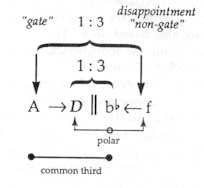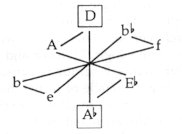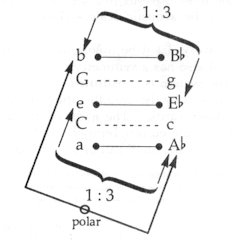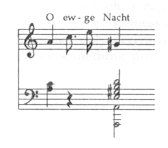Fig. 9

Mozart puts his finger on the main feature
of the mentioned ’fermentation’, realizing that the birth of SI entails
the possibility of the augmented triad: the Sprecher sings an augmented
triad melody,
Fig. 10

and this possibility is exploited by Mozart
at other points as well: think of "Zurück!"
Fig. 11

Reference must be made to an essential
connection between chords with a common third, of which the classical
study of harmony forgets to mention the most important fact: namely, that
(in the overwhelming majority of cases) chords with a common third appear
as the VI. degree — as the VI. degree of the major and minor scale.
The VI. degree of C major is A minor and the VI. degree of C minor
is Ab major.
The common third (the note C) is identical with the key note. It is not
the most effective way of pitting a major against a minor to put C major
opposite C minor, but to have their VI. degrees contrasted: A minor
and Ab major, just as in
the following Brangäne-Tristan dialogue. When Tristan (and with him
the Ab major) appears, he
almost ’loses his mind, his consciousness’ (though in an ironical sense
here): Wagner presents a genuine ’minor effect’ to us:
Fig. 12

As for the Sprecher’s scene, the minor
VI. degree and the major VI. degree determine the formal outline of the
entire dialogue: the Sprecher enters the stage on the minor VI.
degree (with an Ab major
harmony) and when he exits, Tamino arrives at the major VI. degree
(A minor key). This is what carries the liberating thought:
VI.
degree of C minor: Ab major
are chords with a common third.
VI. degree
of C major: A minor
Mozart undoubtedly reserved the most intriguing
harmonic event to the development. It cannot be accidental that the greatest
performers like Toscanini and Bruno Walter placed this moment — "Man opferte
vielleicht sie schon?" — into the focus of the plot dramaturgically as
well.
Already the polar turning-point
indicates that Mozart is to ’try out’ his most daring harmonic effect on
us: D minor and B major are separated by six accidentals, just like the
keys a tritone apart (e.g. F major and B major).
Fig. 13

But let us go back to an earlier point.
(Formerly, I devoted a detailed study to this problem.) In a major tonality
the tonal centre is DO. That causes the predominance of the TI-DO
leading-note steps. In minor keys, however, it is not necessarily LA
that constitutes the tonal centre, but much rather the note MI: the core
of a melody mostly comprises FA-MI steps (think of the main idea
in Mozart’s great
G minor Symphony, or the main theme in Beethoven’s
Appassionata
sonata:
Db-C turns in bs. 1-24).
In our tonal system, the symmetry-pair of the TI-DO leading note
step is the FA-MI step; Mi is the mirror image of DO.
4)
The note MI (note E in A minor) can most
effectively be approached from two sides: from the directions of
FA and RI (F and D#). What is the ’augmented six-five‘ chord?
It is a special chord typical of the minor tonality obtained when the V.
(MI) degree is prepared not simply by the IV. degree,
Fig. 14

but the MI centre is approached from both
sides with chromatic steps: with FA-MI and at the same time RI-MI ’direction
notes’, (that is, with F-E + D#-E turns). In such a case this
tight harmonic relation will almost produce a ’physiological’ effect, as
it were!
Fig. 15

Between each statement of the three-times
repeated motto-theme ("Sobald dich führt..."), which in terms
of form expresses the attainment of the goal, the augmented six-five chord
occurs, lending special weight to the MI centre. The chord first
accents the word "Licht", then underscores the sentence "saget mir: lebt
denn Pamina noch?"
Fig. 16

The nucleus of this harmony — F major
— is the VI. degree of the tonic A minor. B major preparing the development
is, on the other hand, the counterpole — the tritone — of F major. The
model of the polar turn must be traced back to the Neapolitan
chord. The Neapolitan chord and the V-I step following it serve to circumscribe
a tonal centre note, with semi-tone steps, to boot; in A minor key,
the notes Bb and G#
chromatically head towards the note A: 5)
Fig. 17

By the way, we know from earlier experience
that the Bb major Neapolitan
chord is nothing else but the substitute chord of the subdominant
D minor.
The above quoted polar turn ("Man opferte...
sie schon?") is based on a similar attraction — proved unquestionably by
the renderings of Toscanini, Bruno Walter or Karajan — : the melody falls
over the central
E note.
Fig. 18

This time, too, FA and RI play the role
of the ’leading notes’ from two sides (I prefer to use the term ’direction
notes’: the meaning of both FA and RI is expressed by the sphere of attraction
of the
MI centre).
However, the circumscription of the note
LA
cannot be missing, either. Before the outburst of the ’motto-theme’ repeated
ritually three times ("Die Zunge bindet Eid und Pflicht... schwinden")
the notes Bb and G#
perform a similar task: 6)
Fig. 19

In terms of taxonomy, the ’symmetry-pair’
of the G major dominant seventh is the B-D-F-A subminor chord. The character
of the latter is far more lyrical and melodious (’singing’): thanks to
the
LA note. Instinctively, that is how it became the backbone of
the repeated motto-theme:
Fig. 20

The dialogue has a recurring ’leitmotif’
which owes its existence to the direction-notes — precisely to an
element that is the opposite of the leading note step. Let us do ’violence’
upon the leading note of the V. degree (e.g. the note B of G major) by
modifying the note B to Bb
(instead of the tonic resolution): that is, let us have the major third
(B) replaced by a minor third (Bb).
This charges the note Bb
with tension, turning it into a dissonant element, a ’direction note’ requiring
further leading — towards D major. From that point onwards the function
of the dominant is not performed by the G major but by D major (= the secondary
dominant: the dominant of the dominant). The task of the tonic belonging
to D major (i.e. G minor) is simply to restore the equilibrium —
as it was expressed by a great conductor in connection with "Ja, ja, Sarastro
herrschet hier".
Fig. 21

Following the onerous admonition "Tod
und Rache dich entzünden" (concealing an augmented six-five again),
Tamino surfaces with the G major dominant:
Fig. 22

The old priest suddenly tones down his
voice: instead of G major we hear G minor and the continuation conforms
to what was described above.
The G minor and D major chords shown in
Fig.
21 constitute a symmetry-pair, mirroring each other taxonomically.
In this sense, the mirror image of the note Bb
(TA) is F# (FI). It would be redundant to mention this, had
Mozart not made use of its opposite upon the return of the motif. This
time the emphasis is laid not on TA but on FI, which immediately gives
the motif a ’challenging’, provocative character: it becomes a threat to
murder, striking the key of passionate protest, of indignation. The key
is F major (or F minor): "das ist mir schon genug". Were this to occur
in a classical oratorio, the homophonic melody would be answered in the
following way:
Fig. 23

What accounts for the sharp ’challenge’
is the replacement of the C major domi-nant by C minor (the passionate
minor dominant), and just like earlier, the natural continuation is in
G major — where the note B means FI, striking the tone of danger
and threat.
Fig. 24*)

The scale-degrees FA and FI
have a distinguished place even among the ’direction-notes’. FA pulls downwards
(to MI), while FI pushes upwards (to SO). This is a very modern idea in
dramaturgy. The introductory part of the dialogue is tied to C major,
its middle part to C minor and its related keys, while the closing
section returns to the keys without accidentals: first to A minor and finally
to C major.
The question arises what scenic moment
elicits the reprise. In Tamino, the image of the "unglückliches Weib"
(disconsolate mother) evokes the tragic G minor. For the old priest, however,
the "Weib" means something quite different. At first one might think he
is only envious (that is why the sarcastic intonation) but it shows through
the music more and more apparently that she is the opponent, or
even the ’enemy’. Isn’t it peculiar that "Ein Weib" as well as the image
of the enemy is associated with the C major chord? Let us take a closer
look at what is happening here. In G minor the Eb–D
steps give the impression of emotional FA-MI steps; the guiding thread
of the harmonies is made exclusively of Eb–D
steps (earlier I pointed out that FA–MI is the ’emotional’, introverted
element in music):
Fig. 25

As against that, when the Sprecher begins
to speak, — what a turn! — FA is replaced (ousted, to be precise) by FI,
which ushers the dialogue towards SO:
Fig. 26 (Play before it the
former example!)

In connection with the mentioned G minor,
Bb7and Eb
major turns let me refer to another idiomatic turn also behaving like a
leitmotif. In my analyses of Verdi and Wagner I termed this element the
turn-motif.
In Mozart’s music the role assigned to it is to give emphasis (emotionally
charged emphasis) to a word. When, for instance, the root of the A minor
chord is raised a semitone higher, that is, modified to Bb
(NB: the modification giving accent to the chord), a major seventh
(C7) is gained which automatically leads into the substitute
key (F major).
Fig. 27

That’s how we arrive from the first "Zurück!"
to the second gate, from G minor to Eb
major:
Fig. 28

Later we move from the G minor of "Sarastro
herrschet hier" to Eb major
in the same way: raising the basic note of G minor gives edge to Tamino’s
violent "nicht".
Fig. 29

The sentence "Er ist ein Unmensch" is
stressed by a similar motif (G minor, Bb7,
Eb
major).
Fig. 30

The same takes place after "Erklär’
dies Räthsel" (E minor, G7, C major; the raising of the
root note falling on the sentence "täusch mich nicht!"). 7)
Before sketching the tonal structure of
the scene, let us remember an analogy: Tristan’s ’dream chords’ (Brangäne’s
first monologue in Act 2: "Einsam wachend..."). Each group of chords springs
from C# major — and the nadir is reached when C#
major is followed by A minor and E minor triads:
Fig. 31

In the opera C# major signifies
the ’mother’s lap’ (the womb), the ’dream’, the ’night’ — the Nirvana.
The A minor and E minor nadir presupposes the renunciation of this, too:
after C# major A minor establishes an annihilating relation
(not to speak of the fact that the leading note within the C#
major chord [E#] is resolved unnaturally downwards),
while E minor represents a polarly distant relationship with C#
major.
If in the cited dialogue of the Magic
Flute D major symbolizes the ’gate’ of Sarastro’s temple, the concept
of the ’non-gate’ — the moment when Tamino gets ready to leave disappointed
and ’renounces’ the gates — will be represented by Bb
minor and F minor, according to the above logic. D major
and Bb minor are complementary
keys: renouncing each other, while F minor is removed to the other pole
from D major: in our tonal system (e.g. the circle of fifths) the largest
possible distance is expressed by a difference of 6 accidentals. As if
it were the model for the Wagnerian technique: the very point where Mozart
noted in the score "er will gehen" (and the Sprecher asks Tamino: "Willst
du schon wieder geh’n?"), we find ourselves in the Bb
minor key, followed four bars later by F minor.
The contrast becomes even sharper when
it is considered that D major is prepared by a salient, conspicuously emphatic
A major dominant (almost 9 bars in length); attraction and repulsion are
made even more apparent:
Fig. 32

A similar contrast was noted earlier:
Tamino’s youthful, spontaneous utterances were expressed in B minor and
E minor, while the old priest opened up the tonal scope of Ab
major and Eb major:
Fig. 33

As a result of the above-described connections,
a dual, intertwining ’spiral system’ is created in which each element is
balanced off by its counterpole (its tritone-pair):
Fig. 34

Another two arguments are elicited by
the transformation in the wake of "Zurück!". In C major tonality,
the symmetry centre of our tonal system is marked by the D or the Ab
pole. The gate is evoked by D major, the Sprecher appears on the counterpole:
in Ab major. For Bartók,
the inversion of the major pentatony — DO pentatony — became
incarnated in MI pentatony, (projecting the DO pentatonic scale built on
the note D downwards of D, a MI pentatonic scale is produced). The
basic idea of Cantata Profana cannot be separated from the fact
that our tonal system (notation, the stringing of the keyboard instruments,
and in many respects the string instruments) is based on the ’d’ symmetry
axis. Bartók contrasts the DO pentatony based on D with MI
pentatony also based on D. The starting scale of the work rests on the
D=MI pentatonic frame, while the acoustic scale closing the work unfolds
from the D=DO pentatonic scale: (see Fig. 85
on p. 49) 8)
Thus the above two scales are the exact
mirror images of each other. The D=MI pentatonic scale incorporates
the G minor and Bb major
triads. The D=DO pentatonic skeleton of the finale contains first of all
the D major triad, but also the B minor triad. In The
Magic Flute, D major symbolizes the ’gate’ (cf. also Tamino’s rapture
in B minor upon sighting Sarastro’s temple). The D=MI pentatonic scale,
on the other hand, contains the Bb
major and G minor triads: at the turning point, as a consequence
of the word "Zurück!", these very ’reversed’ triads get legitimation:
first Bb major, followed
by G minor (the former after "Zurück", the latter after "Glück").
One more thing should be touched on in
connection with the outcry "Zurück!". This is what triggers off the
radical change that occurs through the entry from the ’major’ world into
the ’minor’ world. On the one hand, C major and its V. degree (G major)
ensure the tonal aura that can be schematized in the following way (every
second step in the figure rhyme in perfect fifths). The formula
also implies the possibility of B minor and E minor (as was mentioned earlier,
Tamino’s temper is governed by the positive substitute chords of
G major and C major: B minor and E minor).
Fig. 35

To produce the above net of fifths
(Fig. 35a), a single C major (or A minor) triad would suffice. Should we
replace C major by C minor, the fifth steps would take the shape
above (Fig. 35b—the relative key of C minor is Eb
major, etc.).
Looking at the two schemata side by side,
one realizes that the relationship between the alternating major and minor
third is
reversed. The second row of thirds goes along the same
path as is covered by the music after the shock of "Zurück!":
| Zurück! |
Glück. |
Zurück! |
...hier. |
Adagio. |
| Bb major |
G minor |
Eb major |
C minor |
Ab major. |
Fig. 36

In the scheme above C major and C minor,
G major and G minor indicate a ’major-minor’ (modal) contrast. A more complicated
case of the major-minor relationship is the contrast of the chords with
a common third: Ab major
and A minor almost present an allegoric contrast (appearance and dissappearance
of the old priest). A similar contrast is created between E minor and Eb
major, B minor and Bb major.
By the same token, the chord with the common third as the enthusiastic
B minor emanating from Tamino’s personality is to become the Bb
major, which expresses the stout resistance of the gate, the shock ("Zurück!").
Tamino’s flaring up in E minor will also have a chord with a common
third: Eb major,
which projects to us the state of mind of the old priest together with
the spiritual world behind him. And if you add to that, that E minor and
Ab major, as well as B minor
and Eb major are spheres
that negate one another (complementary keys), while B minor and Ab
major are polar spheres, then the computer may help you orientate yourself
in this multidimensional network of relations.
The broad cadences illuminate the D
major episode like spotlights: Tamino is standing in front of the temple
gate. The ’map’ of the scene gives similar salience to the importance and
frequence of the G minor episodes: "Ja, ja, Sarastro herrschet hier":
a G minor arrival, right in the foreground of an explosion. And later:
"So gieb mir deine Gründe an!": G minor, before another explosion.
And yet another G minor: "das Gram und Jammer niederdrückt."
In C major, the simplest subdominant and
dominant are represented by D minor and G major. In taxonomic terms: the
symmetry-mirror
of D minor is G major. The symmetry remains intact even if we replace D
minor and G major by D major and G minor, respectively. In
this case, the notes FA and TI are replaced by FI and
TA:
in our system of notation, the nearest (first) sharp and the nearest
flat appears:
Fig. 37

(The frequency of D major and G minor
not only illustrates how the mentioned principle became one of the most
obvious instruments of ’expanding’ the diatonic system, but also suggests
how the ’acoustic’ scale: — DO-scale with FI and TA — was born in Bartók’s
style.)9)
Speaking of the 19th century, let it be
mentioned that the dominant of the A minor key: the E major chord
also has a symmetry pair, the F minor. In the C major key the symmetry
axis of the system is constituted — besides D — by the G# =
Ab note (in the notation,
it is marked by the ’middle’, the third sharp or flat, resp.). One points
upwards, the other downwards.10)
The nadir of disillusionment is scored by Mozart in the F minor
key ("... nie eu’ren Tempel sehn!"), while the development (motto-theme)
is born out of E major. F minor and E major not only satisfy the
requirements of the ’mirror relationship’, but are also chords with
a common third.11)
The Mozartian chromaticism is omnipresent
— ensuring the organic, unbroken connection between the chords. After the
statement "Die Absicht ist nur allzu Klar!" the note B leads to C, then
(extended into a major third) gets emphasis from the C# note
so that the latter could proceed to D as the leading note. The role of
the neckbreaking polar change (D minor—B major) seems to imply that D should
turn into D# and resolve in E. Via the ’turn-motif’, however,
this E also rises to F, which eventually becomes reconciled in the central
E note.
Fig. 38

The basic motif of relief, of ’smoothing
out’ is the DO-RE-MI motif (also on the stage of Wagner and Verdi).
Significantly, the three-times repeated motto-theme is prepared by this
phrase (see Fig. 19 on p. 143).
The cathartic moment follows the introduction
of the motto-theme: "O ew’ge Nacht" — Mozart has the tonic (bass) and the
dominant sound at the same time —hence the time-paralyzing, static
effect:
Fig. 39

The true unfolding — the absolution —
is brought along by the flute solo of Andante. The dual — Eb
major and C major — stage of The Magic Flute has often been discussed
by analysts (Eb major as
the tonality of being initiated, being an ’insider’ in the sacred secret);
this dual tonal stage prevails in the examined dialogue as well.
Compared to C major, the Eb
major chord assumes its expressive character from the notes MA and TA (Eb
and Bb). When the flute solo
taming the beasts is intoned and Tamino’s aria "Wie stark ist nicht dein
Zauberton" is begun, the stage lighting also changes: in our tonal system,
the mirror image of TA and MA are the notes FI and DI – the
aria is dotted with FI and DI colours, which produce the ’fabulous’ natural
aura of the scene:
Fig. 40

In connection with the ’sanctified’ key
of Eb major, let me remind
you of the Sprecher’s theme "... Heiligtum. Der Lieb’ und Tugend Eigentum"
following his introduction. The more so, because it ‘rhymes’ with the closing
act of the above Quintet, quoting almost ’note for note’ its Bb
major melody "Drei Knäbchen jung, schön, hold und weise, umschweben..."
and its smoothingly blissful parallel thirds. Deepening the chords
in thirds (a typical feature of the ’motto’-theme as well) is well known
from the classical literature: it promotes the constant expansion of the
’inner stage’, it keeps intensifying the radiance of the theme.